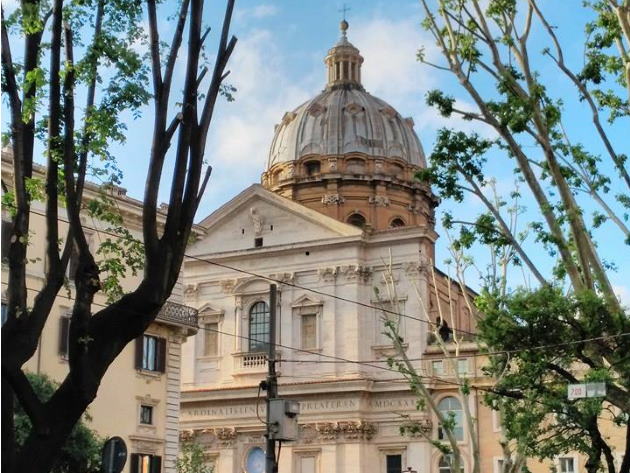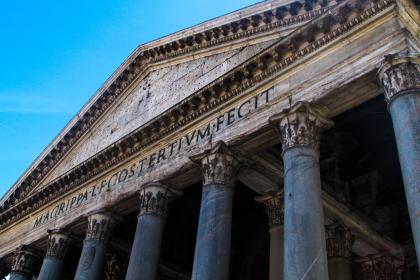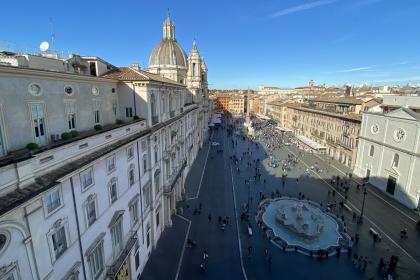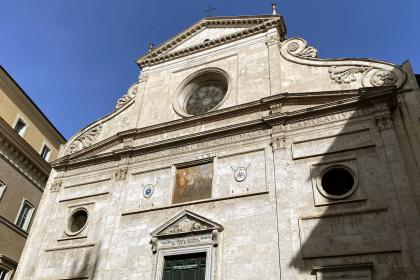
The church of San Biagio e Carlo ai Catinari is located in the Sant'Eustachio district, near the Pantheon. Commissioned by the Barnabites to the architect Rosato Rosati, the current building, which stands on the site of a small church dating back to the 12th century, was built in honor of Cardinal Carlo Borromeo in 1620. The name "ai Catinari" derives from the fact that in nearby there were shops of basin makers.
The church, in Baroque style, is characterized by an imposing travertine façade by Giovanni Battista Soria - who built it around 1635-38 - and is divided into two orders superimposed by a high cornice. The name of Cardinal Leni, who promoted its construction, is engraved in the frieze. Rosati's dome, completed in 1620, has a high drum marked by twelve pilasters between which there are large arched windows and is considered one of the most beautiful domes in Rome, as well as the fourth largest in Rome, after those of the Pantheon, of San Peter's in the Vatican and Sant'Andrea della Valle.
The interior of the building, restored in 1897 for the canonization of Antonio Maria Zaccaria, founder of the Barnabite Fathers, consists of an elongated Greek cross, which took on its current appearance in 1646 with the reconstruction of the apse. At the intersection of the four arms, a large dome rises, whose plumes were painted by Domenichino between 1627 and 1630 with the four cardinal virtues (Prudence, Justice, Fortitude and Temperance). In the apse, with a basin painted in 1646 by Giovanni Lanfranco and depicting San Carlo welcomed into heaven, there are two plaster models for the statues of Saints Peter and Paul found in St. Peter's Square; the main altar, supported by four Corinthian columns and surmounted by Carlo Borromeo's motto - Humilitas - is embellished with a canvas by Pietro da Cortona depicting San Carlo carrying the Holy Nail in procession during the Milan plague, placed in the church in 1667.
Among the other seventeenth-century works of art present in the church are the frescoes by Mattia and Gregorio Preti on the counter-façade, depicting episodes from the life of San Carlo Borromeo, the Annunciation by Giovanni Lanfranco (1624), the Martyrdom of San Biagio by Giacinto Brandi (1678), Santa Cecilia by Antonio Gherardi, the high altar by Martino Longhi the Younger, the Persian Martyrs by Francesco Romanelli and the Death of Saint Anna by Andrea Sacchi.
Finally, on the choir loft to the left of the apse, there is the Rieger Opus 600 organ, built in 1897 to a sound design by Filippo Capocci and restored in 1995 by Angelo Carbonetti.
The Pantheon

 Condividi
Condividi
Navona Square

 Condividi
Condividi
The most iconic square of Baroque Rome
The Basilica of Sant’Agostino in Campo Marzio

 Condividi
Condividi
Information
Mass times
Monday: 08.00Tuesday: 08.00Wednesday: 08.00Thursday: 08.00Friday: 08.00Saturday and public holidays: 08.00Sunday and public holidays: 10.00*During the summer period, the 10.30 service is maintained, Sundays and holidays
Times may be subject to change, so please always contact the church
 Condividi
Condividi
Location
To find out about all accessibility services, visit the Rome accessible section.











































